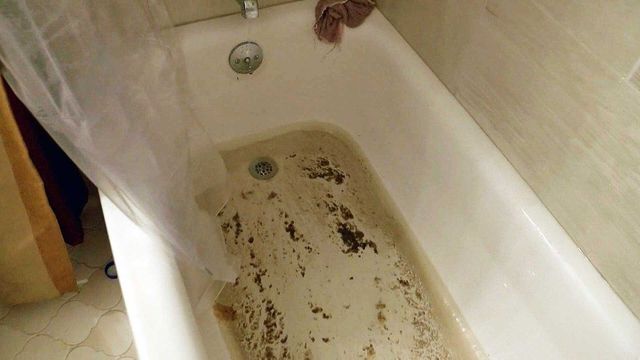An Comprehensive Guide: Drainage Rising Through the Bathtub
An Comprehensive Guide: Drainage Rising Through the Bathtub
Blog Article
Listed here underneath you can locate lots of awesome resources pertaining to Why is There Sewage Coming Up Through the Bathtub.

Sewage backup in the tub can be an upsetting and unhygienic issue for any type of property owner. Not only is it bothersome, however it additionally presents severe health threats and indicates underlying issues with the plumbing system. Comprehending why sewer is turning up with the bath tub is critical for taking proper action to attend to the issue properly.
Introduction to the Issue
Typical Factors for Sewage Backup
Obstructions in the Drain Line
Among one of the most usual reasons for sewage backup is a blockage in the drain line. This can occur due to the accumulation of particles, grease, or foreign things in the pipes, stopping proper circulation and triggering sewer to back up into your bath tub.
Tree Root Breach
Tree origins looking for moisture and nutrients can penetrate drain lines with little splits or joints. With time, these origins can expand and expand, creating significant damage to the pipes and leading to sewer back-up problems.
Recognizing the Trouble
When sewer draws back up into the tub, it's a clear indication of a problem with the drainage system. The wastewater that ought to be streaming away from your home is instead discovering its back right into your home, which can result in significant damage and carcinogen.
Prospective Reasons
A number of factors can add to sewage backup in the bath tub. From obstructions in the sewage system line to problems with the plumbing infrastructure, determining the root cause is crucial for locating a service.
Aging Infrastructure
Older homes may have obsoleted plumbing systems that are more at risk to corrosion, cracks, and damage. As pipelines age, they become more prone to leaks and clogs, raising the probability of sewage backup cases.
Heavy Rainfall or Flooding
During periods of heavy rainfall or flooding, the sewer system may end up being overloaded with excess water, causing back-ups and overflows. This can lead to sewage supporting into bathtubs and various other fixtures inside the home.
Indications of Sewer Backup
Foul Odors
Undesirable smells originating from drains pipes or fixtures, particularly in the restroom, might suggest sewer backup problems. These odors are frequently solid and relentless, signifying an issue that calls for prompt attention.
Slow Draining Fixtures
Bath tubs, sinks, and toilets that drain pipes slowly or otherwise in any way could be experiencing sewer backup. If multiple components are affected at the same time, it's most likely that the problem originates from a typical factor, such as the primary sewage system line.
Gurgling Noises
Unusual gurgling or gurgling sounds originating from drains when water is running somewhere else in the house are a sign of air caught in the plumbing system. This air accumulation can result from sewage back-up and need to be examined quickly.
Health Dangers Associated with Sewer Backup
Contamination of Water Supply
Sewage backup can pollute the water system in your house, positioning a major health risk to you and your family. Direct exposure to infected water can bring about gastrointestinal issues, skin infections, and other ailments.
Mold and mildew Development
Dampness from sewage backup can develop excellent conditions for mold development in your house. Mold and mildew spores can worsen breathing issues and cause allergic reactions in sensitive individuals, making prompt cleanup essential.
Spread of Condition
Sewage has hazardous bacteria, viruses, and bloodsuckers that can trigger a range of conditions, including liver disease, cholera, and gastroenteritis. Entering contact with sewage or infected surface areas puts you in jeopardy of infection.
Tidying up After Sewer Back-up
Disinfection Procedures
Thoroughly disinfect and sterilize impacted locations after sewage back-up to remove hazardous microorganisms and prevent mold development. Use ideal cleaning items and protective equipment to ensure secure and effective cleaning.
Reconstruction of Influenced Locations
Fix any type of damages to floor covering, wall surfaces, or fixtures brought on by sewage backup. Relying on the degree of the damages, you might need to change carpeting, drywall, or other products to recover your home to its pre-loss condition.
Immediate Actions to Take
Shutting Off Water Supply
In the event of sewer backup, it's necessary to shut off the water to stop additional contamination and damages. Find the primary water shutoff valve in your home and shut it off till the problem can be fixed.
Contacting an Expert Plumber
Managing sewer back-up is not a DIY work. Call a qualified plumber with experience in managing sewage-related problems to assess the scenario and carry out necessary fixings or cleanups.
Staying Clear Of Contact with Contaminated Water
Up until the sewage backup is dealt with, prevent contact with contaminated water to stop the spread of germs and pathogens. Wear protective gear if you have to be in the afflicted area and wash your hands thoroughly later.
Safety nets
Routine Maintenance of Drain Lines
Arrange regular inspections and upkeep of your sewer lines to determine and deal with prospective problems before they escalate into significant troubles. This can consist of cleaning out particles, examining for tree origin intrusion, and fixing any kind of damaged pipelines.
Installing Backwater Shutoffs
Think about mounting backwater shutoffs in your plumbing system to avoid sewage from flowing back right into your home throughout durations of heavy rainfall or flooding. These valves automatically close when water starts backing up, shielding your residential or commercial property from contamination.
Appropriate Disposal of Family Waste
Prevent purging anything apart from bathroom tissue and human waste down the commode to stop clogs and obstructions in the sewage system line. Dispose of grease, oil, and other house chemicals properly to lessen the danger of plumbing issues.
Why Is Water Backing Up in My Bathtub When I Flush My Toilet?
What to do about a sewer line clog
First, don’t bother with plunging. No amount of plunging will dislodge the clog in a sewer line. The clog is too far away. Plungers are for clogs in the toilet itself, not the sewer line. Plus, the most likely causes of a sewer clog are:
Tree roots Flushed toys or feminine products Grease buildup Those items don’t move easily. And in the case of tree roots, the roots need to be cut out of the pipe and the pipe will need to be repaired.
You’ll need a closet auger. A closet auger is a type of plumber’s snake with a protective cover to keep from scratching the delicate porcelain toilet. If the clog is further down, you may need to remove the toilet or use one of your cleanouts to get to the clog.
We also recommend doing a video inspection of the drain to ensure that the cause of the clog has been completely removed. Otherwise, you could have the same problem again in a few days or weeks.
https://mspplumbingheatingair.com/blog/why-is-water-backing-up-in-my-bathtub-when-i-flush-my-toilet

I am very eager about Why is Sewage Backing Up Into My Bathtub? and I'm hoping you liked my article. Are you aware of someone else who is excited by Why sewage is coming up through your bathtub? Do not hesitate to share it. Thanks a lot for going through it.
Schedule Service Now
Report this page